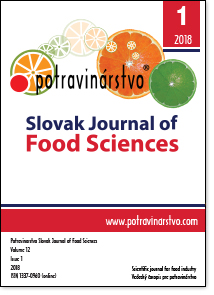Bacteria and yeasts isolated from different grape varieties
DOI:
https://doi.org/10.5219/878Keywords:
bacteria, yeasts, grape, mass spectrometryAbstract
The aim of this study was to isolate and identify bacteria and yeasts in different grape samples. The samples were collected in September 2017. Used 13 grape samples in this study (9 white and 4 red) were from the local Slovak winemakers. Alibernet, Irsai Oliver, Dornfelder, Blue Frankish, Feteasca regala, Green Veltliner, Pálava, Mūller Thurgau, Rhinriesling, Cabernet Savignon, Pinot Blanc, Savignon Blanc and Welschriesling. Two cultivation media were used for detection of bacteri and yeasts in grape samples. Malt extract agar base (MEA) and Tryptone Soay agar (TSA) were used for the cultivation of bacteria and yeasts. Cultivation was performed by spread plate method. Ethanol/formic acid extraction procedure was used for preparation of samples. MALDI-TOF Mass Spectrometer (Microflex LT/SH) (Bruker Daltonics, Germany) was used for identification of bacteria and yeasts. In total, 8 genera of yeasts, 8 genera of Gram-negative bacteria and 10 of Gram-positive bacteria were identified. Together 333 isolates, yeasts, Gram-negative and Gram-positive bacteria were identified.
Downloads
Metrics
References
Albergaria, H., Arneborg, N. 2016. Dominance of Saccharomyces cerevisiae in alcoholic fermentation processes; role of physiological fitness and microbial interactions. Applied Microbiology and Biotechnology, vol. 100, no. 5, p. 2035-2046. https://doi.org/10.1007/s00253-015-7255-0 PMid:26728020 DOI: https://doi.org/10.1007/s00253-015-7255-0
Barata, A., Malfeito-Ferreira, M., Loureiro, V. 2012. The microbial acology of wine grape berries. International Journal of Food Microbiology, vol. 153, no. 3, p. 243-259. https://doi.org/10.1016/j.ijfoodmicro.2011.11.025 DOI: https://doi.org/10.1016/j.ijfoodmicro.2011.11.025
Bokulich, N. A., Thorngate, J. H., Richardson, P. M., Mills, D. A. 2014. Microbial biogeography of wine grapes is conditioned by cultivar, vintage, and climate. Proceedings of the National Academy of Sciences, vol. 111, no. 1, p. E139-E148. https://doi.org/10.1073/pnas.1317377110 DOI: https://doi.org/10.1073/pnas.1317377110
Du Toit, M., Engelbrecht, L., Lerm, E., Krieger-Weber, S. 2010. Lactobacillus: the next generation of malolactic fermentation starter cultures - an overview. Food Bioprocess Technology, vol. 4, no. 6, p. 976-906. https://doi.org/10.1007/s11947-010-0448-8 DOI: https://doi.org/10.1007/s11947-010-0448-8
Drożdż, I., Makarewicz, M., Sroka, P., Satora, P., Jankowski, P. 2015. Comparison of the yeast microbiota of different varieties of cool-climate grapes by PCR-RAPD. Potravinarstvo, vol. 9, no. 1, p. 293-298. https://dx.doi.org/10.5219/484. DOI: https://doi.org/10.5219/484
Fleet G. H. 2007. Wine, p. 863-890. In: Doyle M. P. and L. R. Beuchat (eds). Food Microbiology Fundamentals and Frontiers. 3rd ed. Washington, USA : ASM Press. https://doi.org/10.1128/9781555815912.ch41 DOI: https://doi.org/10.1128/9781555815912.ch41
Hendrickx, M., Goffinet, J-S., Swinne, D., Detandt, M. 2011. Screening of strains of the Candida parapsilosis group of the BCCM/IHEM collection by MALDI-TOF MS. Diagnostic Microbiology and Infectious Disease, vol. 70, no. 4, p. 544-548. https://doi.org/10.1016/j.diagmicrobio.2011.04.006 PMid:21767712 DOI: https://doi.org/10.1016/j.diagmicrobio.2011.04.006
Jolly, N. P., Varela, C., Pretorius, I. S. 2013. Not your ordinary yeast: non-Saccharomyces yeasts in wine production uncovered. FEMS Yeast Research, vol. 14, no. 2, p. 215-237. https://doi.org/10.1111/1567-1364.12111 DOI: https://doi.org/10.1111/1567-1364.12111
Kántor, A., Kačániová M. 2015. Diversity of Bacteria and Yeasts on the Surface of Table Grapes. Scientific Papers: Animal Science and Biotechnologies, vol. 48, p. 149-155
Kántor A., Petrová J., Hutková J., Kačániová M. 2016. Yeast diversity in new, still fermenting wine „federweisser". Potravinarstvo, vol. 10, no. 1, p. 120-125. https://doi.org/10.5219/547 DOI: https://doi.org/10.5219/547
Kántor, A., Mareček, J., Ivanišová, E., Terentjeva, M., Kačániová, M. 2017. Microorganisms of grape berries. Proceedings of the Latvian Academy of Sciences. Section B. Natural, Exact, and Applied Sciences, vol. 71, no. 6, p. 502-508. https://doi.org/10.1515/prolas-2017-0087 DOI: https://doi.org/10.1515/prolas-2017-0087
Nedomová, Š., Kumbár, V., Pavloušek, P., Pytel, R., Začal, J., Buchar, J. 2016. Influence of harvest day on changes in mechanical prorties of grape of grape. Potravinarstvo, vol. 10, no. 1, p. 181-187. https://doi.org/10.5219/600 DOI: https://doi.org/10.5219/600
Padilla, B., García-Fernández, D., González, B., Izidoro, I., Esteve-Zarozo, B., Beltran, G., Mas A. 2016. Yeast biodiversity from DOQ priorat uninoculated fermentations. Frontiers in Microbiology, vol. 7, p. 930, https://doi.org/10.3389/fmicb.2016.00930 DOI: https://doi.org/10.3389/fmicb.2016.00930
Pozo-Bayon, M. A., Alegria, E. G., Polo, M. C., Tenori, C., Martin-Alvarez P.J ., Calvo de la Banda, M. T., Ruiz-Larrea, F., Moreno-Arribas, M. V. 2005. Wine volatile and amino acid composition after malolactic fermentation: effect of Oenococcus oeni and Lactobacillus plantarum starter cultures. Journal of Agricultural and Food Chemistry, vol. 53, no. 22, p. 8729-8735. https://doi.org/10.1021/jf050739y DOI: https://doi.org/10.1021/jf050739y
Pan, Y. L., Chow, N. H., Chang, T. C., Chang, H. C. 2011. Identification of lethal Aspergillus at early growth stages based on matrix-assisted laser desorption/ionization time-of-flight mass spectrometry. Diagnostic Microbiology and Infectious Disease, vol. 70, no. 3, p. 344-354. https://doi.org/10.1016/j.diagmicrobio.2011.03.007 DOI: https://doi.org/10.1016/j.diagmicrobio.2011.03.007
Raymond Eder, M. L., Reynoso, C., Lauret, S. C., Rosa, A. L. 2017. Isolation and identification of the indigenous yeast population during spontaneous fermentation of Isabella (Vitis labrusca L.) grape must. Frontiers in Microbiology, vol. 8. https://doi.org/10.3389/fmicb.2017.00532 DOI: https://doi.org/10.3389/fmicb.2017.00532
Renouf, V., Strehaiano, P., Lonvaud-Funei, A. 2007. Yeast and bacteria analysis of grape, wine and cellar equipments by PCR-DGGE. International Journal of Vine and Wine Sciences, vol. 41, no. 1, p. 51-61. https://doi.org/10.20870/oeno-one.2007.41.1.858 DOI: https://doi.org/10.20870/oeno-one.2007.41.1.858
Varela, C., Borneman, A. R. 2016. Yeast found in vineyards and wineries. Yeast, vol. 34, no. 3, p. 111-128. https://doi.org/10.1002/yea.3219 DOI: https://doi.org/10.1002/yea.3219
Wieser, A., Schneider, L., Jung, J., Schubert, S. 2012. MALDI-TOF MS in microbiological diagnostics identification of microorganisms and beyond (mini review). Applied Microbiology and Biotechnology, vol. 93, no. 3, p. 965-974. https://doi.org/10.1007/s00253-011-3783-4 DOI: https://doi.org/10.1007/s00253-011-3783-4
Wolfe, B. E., Dutton, R. J. 2015. Fermented foods as experimentally tractable microbial ecosystems. Cell, vol. 161, no. 1, p. 49-55. https://doi.org/10.1016/j.cell.2015.02.034 DOI: https://doi.org/10.1016/j.cell.2015.02.034
Downloads
Published
How to Cite
Issue
Section
License
This license permits non-commercial re-use, distribution, and reproduction in any medium, provided the original work is properly cited, and is not altered, transformed, or built upon in any way.






























